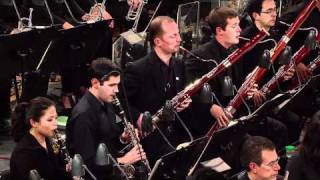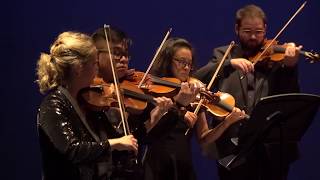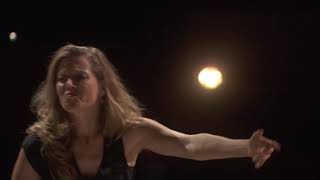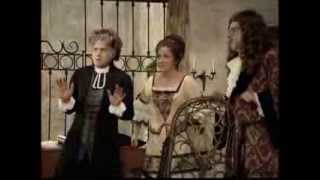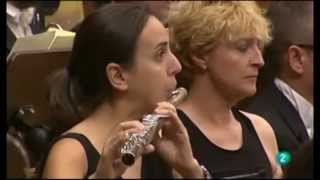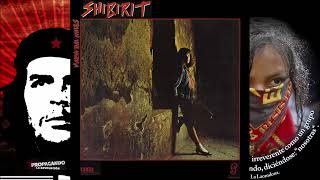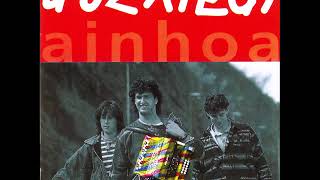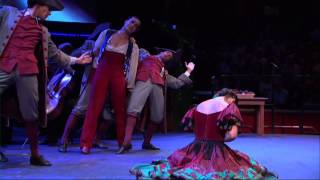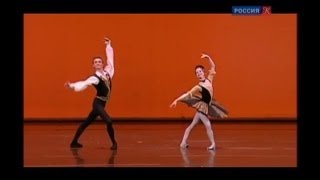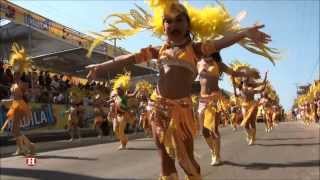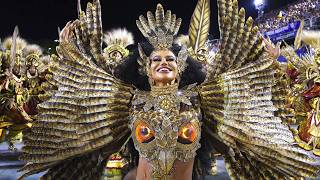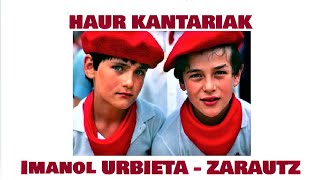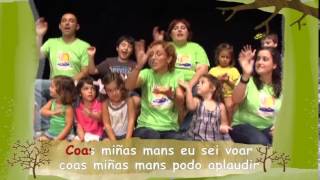February 28th is the day of Andalusia
Gioachino Rossini was born on February 29, 1792
March 1st is Carnival Saturday
Frédérik Chopin was born on March 1, 1810
Recommended music videos for initiation to classical music
Andalusia Day is celebrated on February 28 and commemorates the day of the referendum on the initiative of the Andalusian autonomous process in 1980 that gave full autonomy to the Andalusian community, after the large autonomist demonstrations of December 4, 1977. On December 4, 2022, the Andalusian Flag Day was celebrated for the first time, as a tribute to that demonstration on December 4. Today, February 28 is a holiday in all Andalusian towns; bread with olive oil and sugar is eaten in towns and cities and especially in schools. Educational centers commemorate this holiday a few days before so that students know the traditions of their land. In addition to eating mollete antequerano with oil and sugar or salt, some schools organize a party to show some elements of Andalusia , such as the Anthem of Andalusia and the characteristic clothing of Andalusian culture, encouraging students to come to school dressed in such clothing if they wish. In the case of girls, they dress in flamenco dress , and boys in short Andalusian costume , since it is an icon of Andalusian culture.
El Kanka (Juan Gómez Canca, Málaga, October 9, 1982) is a Spanish singer-songwriter, composer and musician. Since he began his solo career in 2007, he has managed to establish himself as one of the best extras of the new generation of singer-songwriters in Spain . He completed the first year of higher education in Economics , where he began to excel with the guitar. Frustrated by not feeling internally fulfilled, he began to study Philosophy , while combining it with studying guitar at the Conservatory. Later he moved to Madrid , where he began to teach guitar classes; it was then that he began to participate in different competitions, becoming one of the most awarded artists in Spain. Being included in the new generation of Spanish singer-songwriters, his presence on social networks stands out, especially on YouTube , where he has more than 245,000 subscribers and 50,000,000 views and on Spotify , with around a million monthly listeners and with more than 20 songs that exceed a million listens.
Frédéric Chopin (1810-1849) was a Polish virtuoso pianist and composer; as a pianist, he is considered one of the most important in history and as a composer, one of the leaders of Romanticism . He was born into a family with a musical vocation; his mother played the piano and his father, the violin and the flute; his first teacher was a sister with whom he liked to play four-handed pieces. At the age of eight he gave his first public concert at the Radziwill family palace in Warsaw . Chopin 's work focuses exclusively on the piano, solo or concertante, with which he embarked on a solo career of technical perfection, expressive splendor and deepening in rubato until he became the musical reference for that instrument.
Catalogue of Chopin's works . His works are classified by their Opus number (from the Latin opus 'work'; op. abbreviation) which is a term used in music to catalogue the works of most composers since the 17th century .
The Grande Valse Brillante in E flat major, Op. 18 , was composed by Frédéric Chopin in 1833 and published in 1834. This was the first waltz for solo piano that he composed, although before 1834 he had written at least sixteen waltzes that were either destroyed or, some, published posthumously. In 1909 Igor Stravinsky made an orchestral arrangement of this waltz for the ballet Les Sylphides , commissioned by Sergei Diaghilev .
Today we are invited to see Valentina Lisitsa (1973), a Ukrainian pianist who has lived in the USA since 1991. She began studying piano at the age of three and later enrolled at the Kiev Conservatory , where she met her husband Alexei Kuznetsoff , also a pianist. Lisitsa has sought out her audience through her own YouTube channel, for which she has recorded a multitude of performances, and is currently the most viewed classical concert performer on the Internet.
Hector Berlioz (1803-1869) was a French composer, a leading figure in programmatic music and Romanticism in general. He studied in Paris and Rome , where he was on a scholarship, studying the hymns of his teacher, Jean-François Lesueur , and imitating Beethoven , who was then unknown in France , as well as Gluck, Mozart, Étienne Méhul and Carl Maria von Weber. In 1844 he composed the first known work for saxophone, the sextet Canto Sagrado , which was premiered under the baton of Berlioz himself and with Adolphe Sax on saxophone. He also wrote several symphonies (among which his best-known work, the Symphonie fantastique , stands out), overtures, operas, cantatas, sacred music, non-theatrical dramatic works, choral works and numerous songs.
An overture is an instrumental introduction to an opera or other dramatic work, whether musical or not; although some independent instrumental compositions of the 19th and 20th centuries were also called overtures by their composers. The earliest operas, dating from the early 17th century , did not have overtures but did have an introduction by the vocalists in which they summarized the action that was to follow. Instrumental introductions began to be used regularly in the mid- 17th century ; the German composer Christoph Willibald Gluck was one of the first to use material from his operas for overtures. In this way, they established the emotional profile of the opera that followed.
The overture The Roman Carnival , which we suggest today, is actually the prelude to Act II of the opera Benvenuto Cellini ; an opera that had a lamentable reception both at its debut and at the two subsequent performances that were made during the composer's lifetime; so he decided to present it as an independent work in 1844, obtaining a resounding success.
Today we offer it under the baton of Michael Tilson Thomas (1944), a pianist, composer and important American conductor.
Gioachino Rossini (1792-1868) was an Italian composer of 39 operas, various songs, some piano works and some sacred music. He began composing at the age of 12. In 1812 he was hired by La Scala in Milan where he had a memorable success with “La piedra de toque” ; the following year he premiered his first serious opera, Tancredi, in Venice and soon after he premiered another great success, La italiana in Algiers . In 1815 he settled in Naples where he wrote regularly and without stress with rehearsals and regulated dates. In 1822 he moved to Vienna where he met the admired Beethoven . From Vienna to London , back to Paris and after the premiere of his last opera, Guillermo Tell , he abandoned opera at the height of its economic and popularity at the age of 37. He died at the age of 77.
Il barbiere di Siviglia (The Barber of Seville) is an opera buffa in two acts with music by Gioachino Rossini and an Italian libretto by Cesare Sterbini , based on the comedy of the same name (1775) by Pierre-Augustin de Beaumarchais . The premiere, under the title Almaviva, or the Useless Precaution, took place on 20 February 1816, at the Teatro Argentina in Rome . The plot relates the adventures of a couple in love, the Count of Almaviva and the young orphan Rosina. Bartolo , the girl's tutor, also courts her despite their age difference. To prevent this, the couple avails themselves of the help of the barber Figaro , who through intrigues deceives Bartolo and manages to unite the lovers in marriage.
Today we offer Rosina 's aria Una voce poco fa from Act I performed by the Polish coloratura contralto Ewa Podles .
Recommended classical music videos
Marc-Antoine Charpentier (1643 – 1704) was a French composer of the Baroque period. A prolific (551 works) and versatile composer, he is best known for his " Te Deum " H.146 (in the key of D Major), whose prelude, in the form of a rondo, has served as the opening or theme song for television programmes distributed through the Eurovision network and is especially known for being the opening and closing of the Eurovision Song Contest and the Vienna New Year's Concert .
It was his acquaintance with the music of Giacomo Carissimi in Rome , where he was studying painting, that inclined Charpentier 's vocation towards the art of sounds. A disciple of this Italian master, upon his return to Paris in 1672 Molière took him on as a composer for his theatre company, which earned him the enmity of the influential Jean-Baptiste Lully , who until then had been the playwright's closest collaborator. In 1679 he was appointed chapel master to the Dauphin, a post he lost as a result of Lully 's opposition. In his work Charpentier achieved a synthesis of Italian and French traditions, especially in the field of sacred vocal music, to which his famous Te Deum belongs. He also excelled in opera, a field in which he produced titles such as Les arts florissants (1673), Actéon (1690) and Medée (1693).
Hugh Wiley Hitchcock has compiled a thematic catalogue of the work of Marc-Antoine Charpentier ( H. Wiley Hitchcock, Les œuvres de Marc-Antoine Charpentier, Paris, Picard, 1982 ). References in this catalogue are preceded by the letter H .
Concert pour 4 parties de violes, H. 545 It is structured in six movements: I (0´00´´) PRELUDE 1 .-. II (1´30´´) PRELUDE 2 .-. III (3'07'') SARABANDE .-. IV (5´43´´) GIGUE ANGLOISE .-. V (7´07´´) GIGUE FRANÇOISE .-. VI (8´31´´) PASSECAILLE. Today it is offered to us by the Fingernoise Chamber Orchestra .
The Austrian composer Franz Joseph Haydn (1732-1809), whose brother Michael Haydn was also a notable composer, was one of the main pillars on which classicism was based (1750-1820). At the age of six he began his musical studies on harpsichord and violin. At the age of eight he was admitted as a chorister at St. Stephen's Cathedral in Vienna where he continued his studies in singing, piano and violin. After losing his voice, he had to survive by working in various jobs, while studying composition by analysing the works of Carl Philipp Emanuel Bach . He maintained a close friendship with Mozart and was Beethoven 's teacher . He laid the main foundations of the sonata form and the formal structure of the string quartet and the symphony. He died at the age of 77 in Vienna .
The catalogue of Haydn's works . The works of Joseph Haydn are now classified according to the system devised by Anthony van Hoboken. Each work is identified by a Roman numeral corresponding to the category, which in most cases is identified by a genre. Some categories have subdivisions, which are indicated by a lower-case letter followed by an Arabic numeral corresponding to the order of the particular work within the category. These numerals are preceded by the word Hoboken (in memory of the author of the catalogue) and sometimes by Hob (his abbreviation).
Sturm und Drang (storm and assault) is a term that does not come from music but from literature; this term is understood as a reaction against the Baroque . In music, polyphonic structure and speculation or mathematical symbolism are criticized, as well as formulas that do not allow an adequate and simple expression, the objective, rational and comprehensible method. The conception of the term affect (in the objective sense of the Baroque ) is changed to the term feeling (in the subjective sense of the StudD ). In Sturm und Drang the origin of music is sought in the inner nature of man; now it is no longer only vocal music that can express something through words, now also instrumental music itself is capable of expressing itself.
Symphony No. 49 was written in 1768 by Joseph Haydn . Its nickname "The Passion" is believed to come directly from the musical characteristics of the composition: structure of the archaic Sinfonia da Chiesa (slow, fast, slow, fast) , in minor mode and the association with the author's Sturm und Drang period. According to H. C. Robbins Landon it is a work of "dark colors, somber, and even tragic". The symphony is structured in four movements: I (0´00´´) ADAGIO .-. II (11´39´´) ALLEGRO DI MOLTO .-. III (18´47´´) MENUET E TRIO .-. IV (24´02´´) FINALE. PRESTO. Today, the Orchestre Philharmonique de Radio France, conducted by Canadian maestro Barbara Hannigan, brings us the performance.
Opera (from Latin opera, plural of opus, "works") is a musical genre that combines symphonic music, generally performed by an orchestra, and a written dramatic text - expressed in the form of a libretto - performed vocally by singers of different ranges: mainly soprano, mezzo-soprano and contralto for the female register and tenor, baritone and bass for the male, in addition to the so-called white voices (those of children) or falsetto (castrato, countertenor). Generally, the instrumental part contains overtures, interludes and musical accompaniments; while the sung part can be a chorus, solo, duet, trio or various combinations and with diverse structures such as recitative or aria.
It should also be noted that within the musical-dramatic genre there are various genres, such as classical opera, chamber opera, operetta, musical, singspiel and zarzuela . On the other hand, as in theatre, there is dramatic opera ( opera seria ) and comic opera ( opera buffa ), as well as a hybrid between the two: dramma giocoso . As a multidisciplinary genre, opera brings together music, singing, dance, theatre, scenography, acting, costumes, make-up, hairdressing and other artistic disciplines. It is therefore a work of collective creation, essentially based on a librettist and a composer, and where vocal performers play a primary role, but where musicians and the orchestra conductor, dancers, creators of sets and costumes, and many other figures are equally essential. On the other hand, it is a social event, so it has no reason to exist without an audience to witness the show. For this reason, over time it has been a reflection of the various currents of thought, political and philosophical, religious and moral, aesthetic and cultural, typical of the society where the works were produced.
Il barbiere di Siviglia (The Barber of Seville) is an opera buffa in two acts with music by Gioachino Rossini and an Italian libretto by Cesare Sterbini , based on the comedy of the same name (1775) by Pierre-Augustin de Beaumarchais . The premiere, under the title Almaviva , or the Useless Precaution, took place on 20 February 1816, at the Teatro Argentina in Rome . The plot relates the adventures of a couple of lovers, the Count of Almaviva and the young Rosina , with Bartolo , the girl's tutor, who also courts her despite their age difference. To prevent this, the couple avails themselves of the help of the barber Figaro , who through intrigues deceives Bartolo and manages to unite the lovers in marriage. Rossini's Barber has proven to be one of the great comedic masterpieces in music, and has been described as “the comic opera of all comic operas.”
Today we are treated to the role of Luigi Alva (tenor), Enzo Dara (bass), Teresa Berganza (mezzo), Hermann Prey (tenor), Paolo Montarsolo (bass), Stefania Malagu (mezzo), Renato Cesari (bass), Hans Kraemmer (silent role), Luigi Roni (basse), Karl Schaidler (bass), Chorus and Orchestra of the Teatro alla Scala, conducted by the late Italian maestro Claudio Abbado (1933-2014).
Ángel Illarramendi Larrañaga (1958) is a Basque musician and composer, born in Zarautz , Gipuzkoa ; he studied harmony, counterpoint, fugue and composition with Francisco Escudero . His main work has focused on the field of cinematography and theatre with notable soundtracks for films such as Tasio (1984) by Montxo Armendáriz ; El hijo de la novia (The Son of the Bride ) by Juan José Campanella ; Teresa, the Body of Christ by Ray Loriga ; Arlecchino, il servitore di due Padroni by Goldoni ; and The Trojan Women by Euripides . He has also collaborated with a wide range of film directors such as Gracia Querejeta, Pedro Olea, Helena Taberna, Anjel Lertxundi, Albert Boadella, Héctor Olivera, Antonio Hernández and Manuel Gutiérrez Aragón , highlighting his intense collaboration with the producer Elías Querejeta . He is also the author of several chamber works, seven Symphonies , a Concerto for clarinet, piano, viola and orchestra , two symphonic poems, a chamber opera, a suite for orchestra...
Today we offer the suite of the soundtrack of the film 'El hijo de la novia' by Juan José Campanella composed by Ángel Illarramendi in a performance by the RTVE Orchestra conducted by maestro Juan José García Caffi
Recommended music videos for all tastes
María Eva Avilés is a Mexican singer and songwriter from Mexico City . She has been a teaching artist for the Guggenheim Museum in New York's Learning Through Art program in Mexico and has collaborated on several occasions with Radio Svizzera Italiana (Switzerland). In 2001, she won the National Competition for Shows for Hospitalized Children, from the National Council for Culture and the Arts , with her winning show “ A viajar con los quitapesares” (To Travel with the Pessimists ). She also tours hospitals serving children in the third level of the hospital as part of the HospitalArte program. In addition to her own compositions, her repertoire includes a variety of musical genres, from Sephardic to contemporary songs , including blues, bossa-nova , traditional Mexican songs , French and Italian songs performed in their original languages.
Gozategi is a Basque music group that achieved great success in the Basque Country with trikitixa (small Basque accordion) tunes in the 1990s. The group consists of siblings Asier Gozategi and Ainhoa Gozategi and others. The group Gozategi brought an unusual format to trikitixa : the trio. They added another member to the traditional pair of “accordion” and tambourine players: the bass and the brass. Asier Gozategi (trikitixa and vocals), Ainhoa Gozategi (tambourine and vocals) and Iñigo Goikoetxea (bass, brass) began offering romerías in 1992 under the name Gozategi Anai-arrebak . Later, they became Gozategi . Elkar later introduced them as representatives of the new generation of trikitilaris, releasing their first album: Gozategi (1995). He highlighted the youth, freshness, vitality and colour of the trio's music, adding that it was "for young listeners of all ages".
Ainhoa (Elkar 1996), the album we are offering today, was her second album and her biggest hit, specifically with the song Nirekin (6´23´´). It was a summer song from 1996 and the slogan "emoixtaxux muxutxuek ..." spread by word of mouth.
Dido ( born Florian Cloud de Bounevialle ) is a British singer-songwriter. She rose to fame with her debut album, No Angel (1999), which sold 21 million copies worldwide and won several awards, becoming the best-selling album of 2001. Her subsequent works continued to strengthen her success, making Dido the best-selling British female singer in the US . In total, Dido has sold 40 million records and singles worldwide and has been awarded a number of major awards including an MTV Europe Music Award, several NRJ Awards, several BRIT Awards, two Grammy nominations and an Academy Award nomination.
The origin of Carnival seems to come from the festivals that were celebrated in the Roman Empire in honor of Bacchus , god of wine and partying, to celebrate the arrival of spring. In Western culture, Carnival is associated with Catholicism, since Ash Wednesday marks the beginning of Lent , after which comes Holy Week ; all days of contemplation and penitence. Thus, knowing what is coming, the last day of the festival is celebrated, Shrove Tuesday ; a festival that begins the previous Thursday, called Fat Thursday or Thursday . The characteristic of these days basically consists of the celebration in the street of a festive and collective frenzy expressed in costumes, songs, dances, parades and any other occurrence that arises.
Samba is a musical genre with African roots that emerged in Brazil , from which a type of dance is derived. It is one of the main manifestations of Brazilian popular culture and a symbol of national identity. (It should not be confused with Zamba , a completely different musical genre of Argentine origin). Although in some countries the female voice is used (the samba), in Brazil and in some countries such as Argentina and Uruguay , the male voice is used ( the samba ). It was in the former capital of Brazil where the dance of the freed slaves came into contact with other musical genres and incorporated them, acquiring a unique character. In this way, it was the samba carioca that achieved the status of symbol of Brazilian national identity, spreading throughout Brazil , associated with Carnival.
Today we offer this collection of carnival musical works from Brazil .
Recommended peculiar videos
Manuel de Falla (1876-1946), born in Cadiz , was one of the most famous Spanish composers of the last century. From childhood he studied piano with his mother, while his nurse sang him songs that he would remember all his life. In 1901 he met Felipe Pedrell , who awakened his interest in flamenco. In 1899 he completed his official studies at the Conservatory of Madrid . obtaining the first prize for piano at the centre. A few years later he moved to Paris ; however, after the start of the First World War , he had to return to Madrid , and after the death of his parents, he decided to move to his sister's in Granada ; there he met Federico García Lorca . On 28 September 1939, shortly after the Civil War , he went into exile in Argentina , where he died.
The Three-Cornered Hat , popularly known as the First Flamenco Ballet , is a ballet by Manuel de Falla and choreographed by Léonide Massine based on the novel of the same name by the nineteenth-century writer Pedro Antonio de Alarcón . Commissioned by Sergei Diaghilev and performed by his Ballets Russes , it occupies a special place in the history of theatrical dance of the twentieth century . After its premiere in London in 1919, the work, with sets and costumes by Pablo Picasso , was a resounding success. The Three-Cornered Hat breaks with the traditions that populated the genre of princesses, apparitions and swans.
Today we present it with the mezzo-soprano Clara Mouriz , and the BBC Philharmonic , conducted by Juanjo Mena , a Basque conductor who began his career as a conductor with the Bilbao Symphony, from which, after an excellent performance, he would be launched to the most prestigious European and American formations. The choreography is by the Ballets Russes .
Niccolo Paganini (1782-1840) was an Italian composer and a benchmark of violin virtuosity. A child prodigy, his father forced him to spend long hours studying the violin from a very early age; so that by the age of fourteen his teachers declared themselves incompetent to continue teaching him. As a violin soloist, he toured Italy, Vienna, Prague, Warsaw, Berlin, Paris and London ; admired for his astonishing technique, he received high praise from Liszt and Berlioz , among others; his technique was so admired that it was said of him that he had made a pact with the devil. He wrote numerous works for violin and also for guitar, viola and bassoon. He died of tuberculosis at the age of 58.
Satanella (also known as Le Diable amoureux ) is a ballet in three acts written by the French dancer and choreographer Joseph Mazilier (1801-1868) with music by Napoléon Henri Reber (1807-1880) and François Benoist (1794-1878), musically based on Paganini 's Carnival of Venice . Today we offer several numbers from this ballet performed by Eugenia Obraztsova, prima ballerina of the Bolshoi Ballet in Moscow and the Mariinsky Ballet and Alexander Sergeyev , prima dancer, also of the Mariinsky Ballet .
The Barranquilla Carnival is a folkloric and cultural event held in Colombia . It is celebrated annually in February or early March, between Saturday and Tuesday of Carnival with 28 thousand creators of 845 folkloric groups that participate in the events organized by Carnaval de Barranquilla SAS ., who are part of the three or four million spectators who enjoy the great agenda of the city. Other activities directly related to the Carnival happen during a good part of the year. The first records of the Barranquilla Carnival date back to the 19th century ; this event expresses the great cultural variety and the rich folklore of the Caribbean Region of Colombia , as well as the most peculiar local manifestations, such as popular music and dance. The many costumes that invoke all kinds of animal species, native and strange, are a cause for laughter and scares; African blacks; big heads; crazy people; dolls; superheroes; mythological beings, which transcend the limits of sexuality and death, among an almost endless number of inventions and popular occurrences.
The Rio Carnival . Music, dance and parades of the Samba schools are events that explode in all their splendor. The festival lasts four days, involving people of all ages and visitors from all over the world; four days in which the numerous samba schools of the city compete and which begins with the coronation of King Momo , to whom the Prefect hands over the keys to the city. The main event consists of the parade through the Sambadrome of the aforementioned samba schools ; although the party invades the most remote places in Rio . The video that we present today reflects the parade held in 2022.
Recommended music videos for children
Various Wikipedia articles have been used to write these texts.
The texts of Videomusicalis are written in Basque, Spanish and English.







